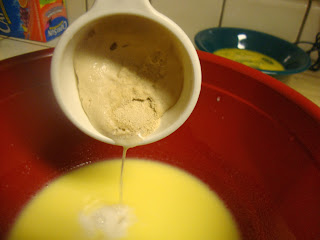I love homemade fresh yeast rolls. There is nothing better than having your whole house smell like fresh baked bread. I decided to make a tutorial for making my mother's recipe for white rolls. Making rolls is the kind of recipe that you need to have a tutorial the first time. Following the recipe is bound to get you "lead-bread" as I found out my first time attempting it. So, here is half of the recipe. The next post will contain the rest.
Gather your ingredients.
Ingredient List2 cups milk: whole milk is the best
Any other "octane" of milk will work.
I have even used dried milk with water and it turned out great
5 1/2 cups white flour (you can replace with whole wheat, but I haven't tested this. Try at your own risk)
2 Tbs dry fast rising yeast OR 2 packages (1/4 oz) dry fast rising yeast
3 Tbs Margarine or butter
3 Tbs Vegetable oil (can replace with canola oil or coconut oil)
2 large eggs
3 Tbs white sugar + 1/2 tsp for proofing yeast
1 Tbs salt
1/4 cup lukewarm water
Choose a large bowl and put the white sugar, salt, vegetable oil, and margarine into the bowl.
In a small bowl, crack both eggs and stir gently a few times with a fork. See below.
Leave eggs in bowl to rest until you need them.
Choose a small pan and measure 2 cups of milk into the pan.
DO NOT TURN ON HEAT YET!
Using the same cup you used to measure your milk, rinse it out and wait for your water to get warm. The water should be lukewarm (75-80 degrees). Put 1/4 cup of water in your cup. Add 1/2 tsp white sugar to the water.
Add your yeast to the water.
This is called proofing your yeast. This is a test to see if your yeast will rise before you place it in the bread. There is nothing worse than forgetting to proof your yeast and finding out after you made the rolls that the yeast is bad. Bad yeast + recipe = Flat nasty rolls. So, proof your yeast first!
Let the yeast sit on the counter while you do other stuff. We will come back to it.
Now you can turn the heat on for your milk! Medium to Medium-High heat.
We are going to scald milk. Make sure you have something to stir the milk. This is the fun part of watching milk heat up. It is like watching grass grow.
Stir your milk occasionally-not lots. You don't want your milk to boil, but almost. You want to warm your milk up to the point it has bubbles forming along the edges of the pan (see picture above).
You are heating the milk to 180 degrees F. Please note- if you live at high altitudes, the visual clues I'm giving you will not happen. So, use your temperature to help you do it.
The milk will stick to the sides of the pan. This is another visual clue that you did it right and not something to worry about. Your milk is not going bad.
Pour your scalded milk into your big bowl with the sugar, salt, oil, and margarine.
Stir with spoon gently until margarine is all melted and dry ingredients are incorporated.
Check your yeast. If your yeast is good, then it will have risen slightly or a lot. If nothing happened. Dump out your yeast/water mixture and repeat the proofing yeast step. You need yeast that reacts or your bread will not rise. This step should take a few minutes-- your milk mixture needs some time to cool down. So, take a minute to get a drink.
Pour in your yeast into the big bowl. You can scrap out the sides with a spatula.
Mix in the yeast with a whisk. Trust me. You need a whisk for this. If you do not own a whisk, use a fork to mix your yeast. You need to make sure the yeast is all mixed in.
Side note: You should invest in a good whisk because it is a very versatile tool and can be purchased for less than $2. I have even found them at the Dollar Store. My sister gave me a whisk when I was in college because she thought it was a sin that I didn't own one. I understand now.
Mix in your eggs. Scrap the sides of your small bowl (green bowl in picture)
with a spatula. Mix in with your whisk.
Add 2 cups of white flour to your bowl and mix in with the whisk. Only 2 cups!
After you have mixed in the first 2 cups of flour with the whisk, you need to change to a spoon. The whisk will not help you after this.
Mix the rest of your flour in, 1 cup at a time, until the mixture is getting sticky and hard to stir. If you don't need the whole amount of flour to get your dough to this point, that is fine! It is better to not over flour your rolls because we will add more flour during the rolling out phase.
Cover your bowl with a CLEAN towel or clear wrap. Let your dough sit somewhere with not too much breeze until the dough has doubled in size. This may take anywhere from 40 minutes to 2 hours.
The next post will take you through what happens after the dough rises.
~Possum






















No comments:
Post a Comment
Note: Only a member of this blog may post a comment.